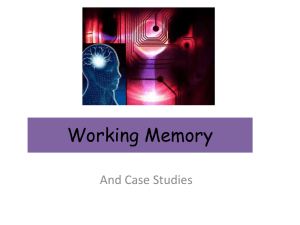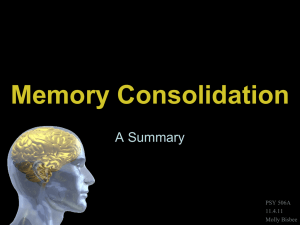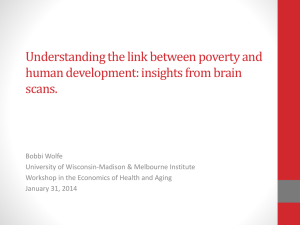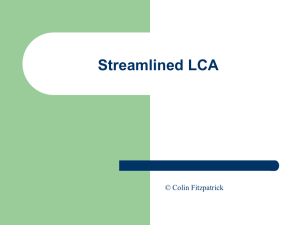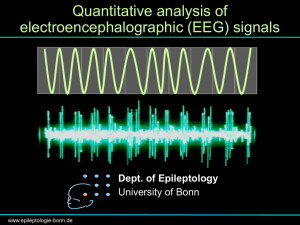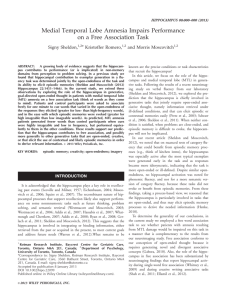Betsy Murray: Animal models of episodic memory in
advertisement
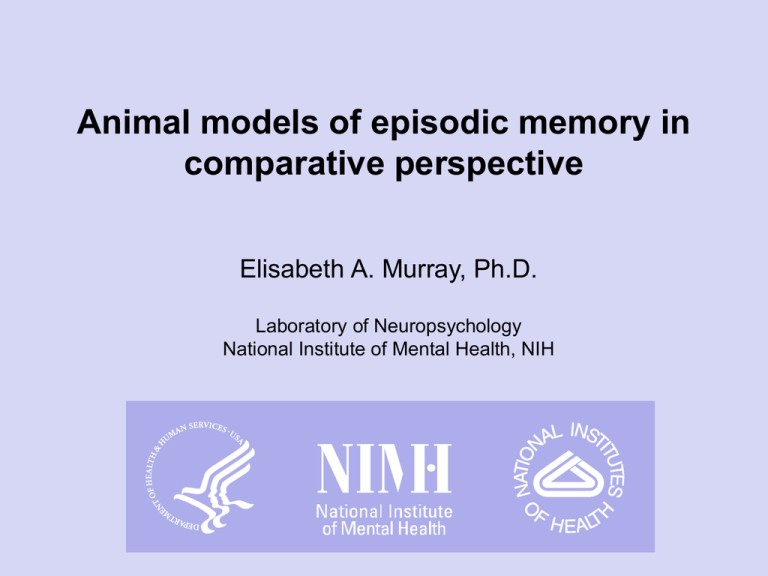
Animal models of episodic memory in comparative perspective Elisabeth A. Murray, Ph.D. Laboratory of Neuropsychology National Institute of Mental Health, NIH Know then thyself, presume not God to scan; The proper study of Mankind is Man… He hangs between; in doubt to act, or rest, In doubt to deem himself a God, or Beast —— Alexander Pope, 1733 That is romantic, and in 1733 man’s place in the biological world was a mystery. But now we now know how we fit in. For each species that enters a psychology lab, we have descended from a “last common ancestor”– the LCA Which leads to: The Prime Directive: Similarity without reference to the LCA is similarity without meaning (we will come back to this) Let’s look at an example highly relevant to episodic memory The cladogram below shows that the amniotes leading to mammals and those leading to birds diverged early in amniote history placentals mammals amniotes LCA marsupials monotremes turtles snakes & lizards crocodiles birds Depiction of a primitive amniote (the LCA of primates & birds) dinosaurs* lissamphibians Similarities between human and scrub jay “episodic” or “episodic-like” memory are very superficial mammals Humans (conscious episodic memory, placentals mental time travel, self-reflection, embedding oneself in events) marsupials monotremes amniotes turtles snakes & lizards crocodiles Scrub jays (what, where, when birds conjunctions) dinosaurs* lissamphibians If the LCA had conscious event memory and MTT, there should be evidence for such advanced cognition in its other descendants placentals mammals marsupials monotremes amniotes turtles snakes & lizards crocodiles birds dinosaurs* lissamphibians Scrub jays and humans show Putting thesebut ideas in a similarities, these comparative are likelycontext due to does not disprove parallel anything, and but ask yourself: does it independent evolution really pass the ‘smell test’? Otherwise, one has to believe that the LCA, a fairly primitive amniote that lived about 320 million years ago, had the same advanced cognitive capacities that characterize human episodic memory Anything can be homologous: •Structures •Behaviors •Physiological processes •Metabolic pathways •Genetic sequences •et cetera Provided that they have been inherited from the LCA If not, then any similarities are homoplaseous and all bets are off about mechanisms & “circuits” Similarity is not enough: similarity without reference to the LCA is similarity without meaning Monkeys, in contrast to scrub jays, diverged from us “only” ~30 million years ago chimps & bonobos split So what can monkeys tell us about our “constructs” when we can’t study the LCA? • Construct 1: Episodic memory • Construct 2: Recognition memory So what can monkeys tell us about memory when we can’t study the LCA? • MTL damage in humans produces amnesia, but early attempts to replicate effects on memory after MTL lesions in monkeys failed – no effects of MTL lesions on object discriminations • Orbach, Milner and Rasmussen, 1960 • Correll and Scoville, 1965 – no effects of MTL lesions on delay tasks • Correll and Scoville, 1967 • Roughly 20 years without major advances in monkey “model” of human memory • Is there a species difference? Have humans and monkeys diverged that much?? Then, Mishkin concluded that humans and monkeys are alike, after all “This close correspondence of [MTL lesion] effects in the two species implies . . . that the clinical syndrome, like the experimental one, could indeed be the result of combined damage to the amygdala and hippocampus. . .” Mishkin et al. (1982) An apparent behavioral homology, and so … The orthodox monkey model of memory was born: Monkeys and humans have inherited a medial temporal lobe “memory system” from their LCA This system includes the episodic memory mechanism How did this orthodoxy come about? Delayed nonmatching-to-sample (DNMS) Sample presentation + 10 sec Choice test - + 30 sec Gaffan, 1974; Mishkin and Delacour, 1975 Recognition memory 100 N 90 A H 80 70 60 Said to be A+H 50 List length Delay 1 10" 1 1 1 30" 60" 120" 3 5 60" + 100" + 10 200" + Mishkin (1978) • This finding & others led to the current orthodoxy: • MTL in monkeys has the same function as MTL in humans • In humans, that function is conscious memory “the fundamental distinction is between the capacity for conscious recollection of facts and events (declarative memory) and nondeclarative memory, which supports … forms of memory that are expressed through performance rather than recollection.”—Clark, Manns & Squire, 2002 • But in monkeys, all memories are assessed by performance, and so we have a problem Despite this problem, the main tenets of the current orthodoxy remain: • MTL is a single “thing” • It (and therefore the hippocampus) subserves conscious (declarative) memory – as demonstrated by the role of hippocampus in visual recognition (DNMS) • It does not contribute to subconscious (procedural, implicit) memory • It does not function in perception Memory Declarative Facts Events Procedural Skills Priming Classical Other Squire, 1987 But the current orthodoxy is wrong: • Monkey studies show that MTL is NOT a single “thing” • Monkey studies also show that the hippocampus is NOT critical for visual recognition • In humans, MTL DOES contribute to implicit spatial memory (Chun & Phelps, 1999) & perception (Lee et al., 2005a, b) • Monkey and human studies show that part of the traditional MTL (PRh) DOES function in perception (Murray, Bussey & Saksida, 2007) The first two points are now taken up, in turn The other two are topics for another time The MTL is not a THING: • Each part contributes to perception & memory in its own specialized way A(IBO) DNMS/FA* tasks Reinforcer devaluation Arbitrary mapping 0 Rh (IBO) 0 (IBO) 0 * Feature ambiguity tasks 0 = no effect H (ASP) 0 Percent Correct Responses The hippocampus is NOT necessary for recognition memory: with or without amygdala 100 90 Control 80 A+H (IBO) Murray & Mishkin (1998) 70 Rh 60 50 10 30 60 120 3 Delay (sec) 5 10 List Length Meunier, Bachevalier, Mishkin & Murray (1993) The hippocampus is also NOT necessary for other aspects of stimulus memory H Trial-unique DNMS 0 Visual-visual paired assoc. Crossmodal DNMS 0 0 = no effect 0 A(IBO) HA(ASP) PRh/Rh 0 0 What about the role of hippocampus in DNMS? •Previously thought to be due to H or H+A lesions •Shown instead to be due to Rh lesion, in most cases •Why only “most” cases? •Stimulus set size •Very small sets (2): •Large sets (300-400): •Very large sets (>1000): 1 Correll strategy STM recency familiarity H lesion effect no1 yes2 no3 and Scoville, 1965 2 Beason-Held et al., 1999; Zola et al., 2000; Gaffan, 1974 3 Murray & Mishkin, 1998; Nemanic et al., 2004 • The failure of the orthodox memory model opens the field to alternative views, which dispense with the MTL as an entity subserving a “memory system”: • • • • Multiple-trace theory (Moscovitch & Nadel. 1997) Temporal-stem theory (Gaffan, 2002) BIC (Eichenbaum, Yonelinas, Ranganath, 2007) Hippocampal-prefrontal theory (Murray & Wise, 2010) • For today, I will focus on 3 possible hippocampal functions, in turn: • Hippocampus for spatial processing • Hippocampus for fast learning • Hippocampus for scene memory The hippocampus was previously thought to be required for 3 types of spatial memory spatial reversal, spatial matching, and object-place associations (all wrong) H(IBO) Spatial reversals Spatial DNMS 0 Object-place association 0 H(ASP) PHC* 0 *PHC = parahippocampal cortex Open-field spatial memory test Delay titration score (min) Open-field spatial memory test 30 25 20 15 10 5 0 Control Hippocampal Hampton et al. (2004) Arbitrary associations Spatially directed responses (joystick task) Ou Tk h L Left Ou Right Down Arbitrary associations Nonspatial responses (touchscreen task) Tp Sh h L TAP 8 Touches < 2 seconds SHORT HOLD 2-4 seconds LONG HOLD > 4 Seconds Fast associative learning Controls Fx or H lesions chance Brasted et al. 2005 One-trial learning PFv+o lesions: abolish 1-trial learning But w/o prior errors or intervening trials, Fx lesions do not PFv+o Fx lesions block 1-trial learning. The loss of this fast, event-capture memory probably slows the overall learning rate Brasted et al. 2005 Object-in-place scenes Courtesy M. Baxter Object-in-place scenes monkeys Adapted from Aggleton et al. (2000) Brain and Gaffan (2002) Philos Trans R Soc Lond B Biol Sci humans Courtesy M. Baxter Hippocampus • Hippocampus essential for spatial memory in naturalistic conditions, fast associative learning & object-in-place scenes task, but why?: – Navigation/spatial? – Large scale? – Episodic? – Explicit recollection? – Fast learning? • Arbitrary visuomotor associations, objects-in-place scene tasks benefit from fast, event-capture memory • Not just spatial: Fornix essential for both spatial and nonspatial visuomotor mappings Hippocampus: episodic vs. semantic memory Children with early hippocampal damage: initially reported to have impairments in episodic memory, with sparing of semantic memory (Vargha-Khadem et al 1997; 2001). More recent studies showed that these lesions DO impair the acquisition of semantic memories (Gardiner et al 2008; Holdstock et al 2002; Manns et al, 2003). Holdstock et al (2002): hippocampus crucial in the rapid acquisition of semantic information, just as in rapid acquisition of episodic memory (Kapur, 1994). Thus, the distinction between the hippocampal cortex and other cortical areas could relate to rapid versus slow learning (McClelland, McNaughton, & O'Reilly, 1995) rather than to episodic versus semantic memory. So what, after all, have monkeys and humans inherited from their LCA? A hippocampus-dependent fast learning mechanism The hippocampus is, of course, a part of the cerebral cortex; other parts of the cortex, including PRh, subserve slow learning This fast learning system is important for episodic memory (event capture), but not only that And the hippocampus does what it has been doing since being inherited from the LCA of the amniotes Discussion points: • • • • • • What is the state of the field in measuring this “construct”? Are there significant limitations in comparing the “construct” across species? Animals models are problematic because the constructs (declarative memory, cognitive memory, episodic memory) depend on consciousness, by whatever label used for it. Are the known neural substrates relevant to neural circuits recruited by this “construct” in humans? Yes, but similarity without reference to the LCA is similarity without meaning. Ideas about how a treatment strategy (pharmacological, cognitive/behavioral) could target this construct A focus on ‘fast’ learning, as opposed to dogmatic ‘tests’ of declarative memory in animals is one way forward. Hippocampus for recollection, not familiarity Courtesy H. Eichenbaum



